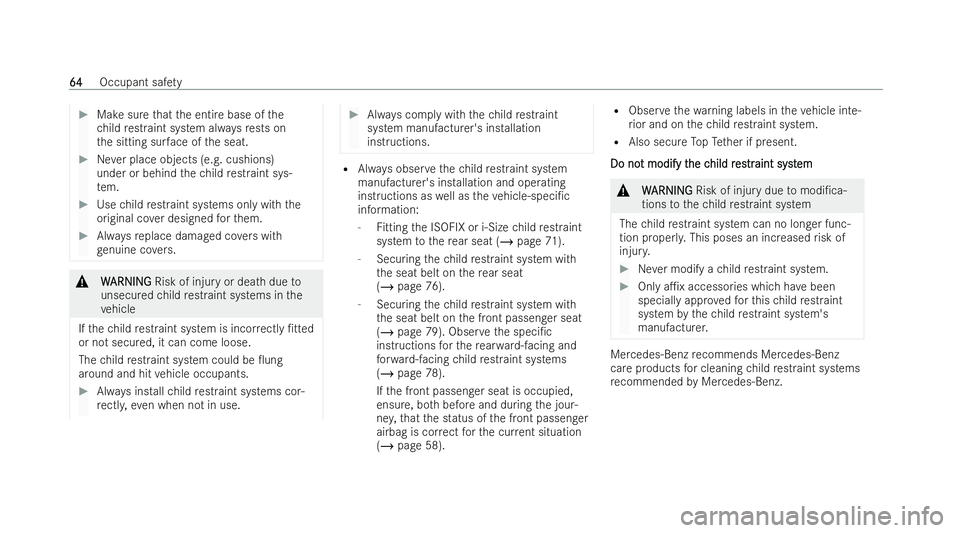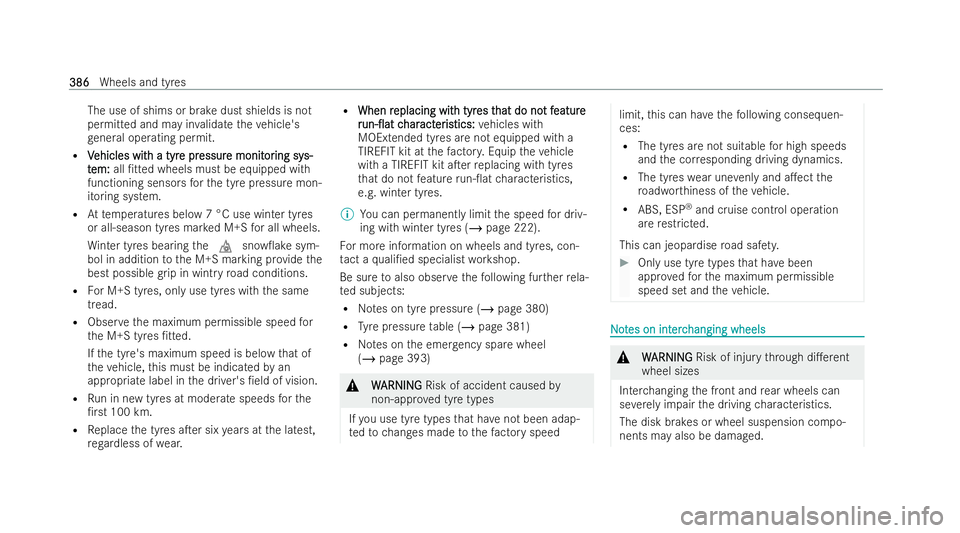Page 67 of 537

#
Make sure that the entire base of the
ch ild restraint system al ways rests on
th e sitting sur face of the seat. #
Never place objects (e.g. cushions)
under or behind thech ild restraint sys-
te m. #
Use child restraint systems on lywith the
original co ver designed forth em. #
Alwaysre place damaged co vers with
ge nuine co vers. &
W
WARNI NG
ARNI NGRisk of injury or dea thdue to
unsecured child restraint systems in the
ve hicle
If th ech ild restraint system is incor rectly �/tted
or not secured, it can come loose.
The child restraint system could be �0ung
around and hit vehicle occupants. #
Always ins tallch ild restraint systems co r-
re ctl y,even when not in use. #
Always comply with thech ild restraint
system manufactu rer's installation
inst ructions. R
Always obser vethech ild restraint system
manufactu rer's installation and operating
inst ructions as well as theve hicle-speci�/c
information:
- Fitting the ISOFIX or i-Size child restraint
system tothere ar seat (/ page 71).
- Securing thech ild restraint system wi th
th e seat belt on there ar seat
(/ page 76).
- Securing thech ild restraint system wi th
th e seat belt on the front passenger seat
(/ page 79). Obser vethe speci�/c
inst ructions forth ere ar wa rd-facing and
fo rw ard-facing child restraint systems
(/ page 78).
If th e front passenger seat is occupied,
ensure, bo thbefore and during the jour-
ne y,that the status of the front passenger
airbag is cor rect forth e cur rent situation
(/ page 58). R
Obser vethewa rning labels in theve hicle inte-
ri or and on thech ild restraint system.
R Also secu reTopTe ther if present.
Do no
Do no t modify t t modify t he c
he child r
hild r es
estrtraint syst
aint syst em
em &
W
WARNING
ARNING Risk of injury due tomodi�/ca-
tions tothech ild restraint system
The child restraint system can no longer func-
tion prope rly. This poses an increased risk of
injur y. #
Never modify a child restraint system. #
Onlya�1x accessories which ha vebeen
specially appr ovedfo rth is ch ild restraint
system bythech ild restraint system's
manufactu rer. Mercedes‑Benz
recommends Mercedes-Benz
care products for cleaning child restraint systems
re commended byMercedes-Benz. 64
64
Occupant sa
fety
Page 80 of 537

A�Ter
thech ild restraint system has been
re mo ved, replace the head restraint immedi-
atel y and adjust all head restraints co rrectl y.
O The backrest of thefo rw ard-facing child
re straint system must, as far as possible, be
re sting on the seat backrest of there ar seat.
O Ifth e head restraint of thech ild seat cannot
be fully extended when it is installed in the
ve hicle, this will result in restrictions on the
maximum size setting forch ild restraint sys-
te ms in weight category II or III.
Contact with thero of when the head
re straint is ful lyex tended and loc ked in place
will not result in any restrictions on use.
O Thechild restraint system must not be put
under strain between thero of and the seat
cushion and/or be �/t tedfacing the wrong
direction. Where possible, adjust the seat
cushion inclination accordingl y.
O Thechild restraint system must not be put
under strain bythe head restraint. Adjust the
head restraints as appropria te. O
Make sure that thech ild's feet do not touch
th e front seat. If necessar y,mo vethe front
seat slightly forw ards. #
Installth ech ild restraint system.
The entire base of thech ild restraint system
must al ways rest on the seat sur face of the
re ar seat. #
Always make sure that the shoulder belt strap
is cor rectly routed from the seat belt outlet of
th eve hicle tothe shoulder belt guide on the
ch ild restraint system.
The shoulder belt strap must be routed
fo rw ard from the seat belt outlet. N No
ot tes on v
es on v ehicles wit
ehicles wit hout aut
hout automatic fr
omatic fr ont
ont
passeng
passeng er airbag
er airbag shut
shuto�.
o�. St
icke r visible when the front passenger door is
open
Ve hicles without automatic front passen ger airbag
shuto�. ha vea special stic ker a�1xed tothe side of
th e cockpit on the front passenger side. Occupant saf
ety
77
77
Page 389 of 537

The use of shims or brake dust shields is not
permitted and may in validate theve hicle's
ge neral ope rating permit.
R V
Vehicles wit
ehicles wit h a tyr
h a tyre pr
e pressur
essur e monit
e monit or
oring sy
ing sy s-
s-
t
t em:
em: all �/t tedwheels must be equipped with
functioning sensors forth e tyre pressure mon-
itoring system.
R Attemp eratures below 7 °C use winter tyres
or all-season tyres mar ked M+S for all wheels.
Wi nter tyres bea ring thei snow�0ake sym-
bol in addition tothe M+S marking pr ovide the
best possible grip in wintry road conditions.
R For M+S tyres, only use tyres with the same
tread.
R Obser vethe maximum permissible speed for
th e M+S tyres �/t ted.
If th e tyre's maximum speed is below that of
th eve hicle, this must be indicated byan
appropriate label in the driver's �/eld of vision.
R Run in new tyres at moderate speeds forthe
�/r st 100 km.
R Replace the tyres a�Ter six years at the latest,
re ga rdless of wear. R
When r
When r eplacing wit
eplacing wit h tyr
h tyres t
es that do no
hat do no t f
t featur
eatur e
e
r
r un-�0at
un-�0at c
char
har act
acter
eris
istics:
tics: vehicles with
MOExtended tyres are not equipped with a
TIREFIT kit at thefa ctor y.Equip theve hicle
with a TIREFIT kit a�Ter replacing with tyres
th at do not feature run-�0at characteristics,
e.g. winter tyres.
% You can permanently limit the speed for driv-
ing with winter tyres (/ page 222).
Fo r more information on wheels and tyres, con-
ta ct a quali�/ed specialist workshop.
Be sure toalso obser vethefo llowing fur ther rela-
te d subjects:
R Notes on tyre pressure (/ page 380)
R Tyre pressure table (/ page 381)
R Notes on the emer gency spa rewheel
(/ page 393) &
W
W ARNING
ARNING Risk of accident caused by
non-appro ved tyre types
If yo u use tyre types that ha venot been adap-
te dto changes made tothefa ctory speed limit,
this can ha vethefo llowing consequen-
ces:
R The tyres are not suitable for high speeds
and the cor responding driving dynamics.
R The tyres wear une venly and a�.ect the
ro adwor thiness of theve hicle.
R ABS, ESP ®
and cruise cont rol operation
are restric ted.
This can jeopardise road saf ety. #
Only use tyre types that ha vebeen
appr ovedfo rth e maximum permissible
speed set and theve hicle. N
No
ot
tes on int
es on int erc
erchanging wheels
hanging wheels &
W
WARNING
ARNING Risk of injury thro ugh di�.erent
wheel sizes
Inter changing the front and rear wheels can
se verely impair the driving characteristics.
The disk brakes or wheel suspension compo-
nents may also be damaged. 386
386
Wheels and tyres